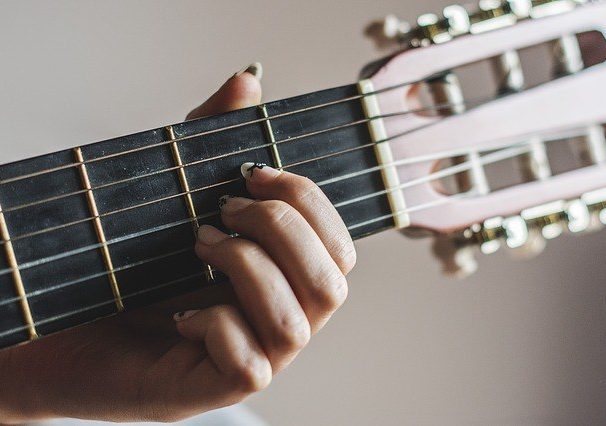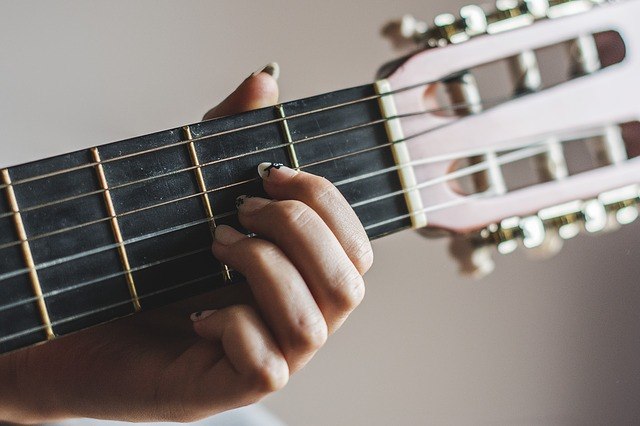
Image by Katrina_S from Pixabay
Dissecting the A chord on guitar can reveal several useful pieces of information. I’ve found that looking at chords in detail teaches you much about how the guitar works. There’s more to a simple open A chord on guitar than meets the eye. So let’s take a closer look.
What is an A chord on guitar?
Any chord that contains only the notes A, C#, and E is an A chord. The open A chord on guitar consists of the open A string, the D string at fret 2 for an E note, the G string at fret 2 for another A note, the B string at fret 2 for a C# note and the open High E string. Many other A chord shapes are available at different areas of the neck.
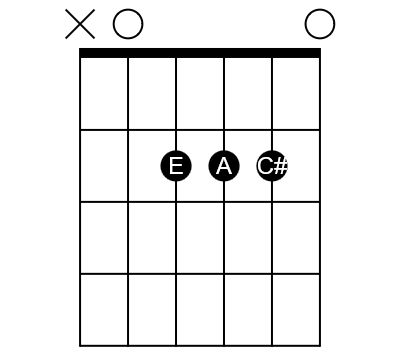
What’s special about the open A chord on guitar?
The open A chord is one of the most important chords on the guitar. Let’s discuss a few reasons why that’s so.
The A chord has a full sound
The open A chord on guitar provides a strong, powerful sound. The chord contains two open strings, including the open A string which, as the second thickest string on the guitar, produces a deep, powerful note to fill out the bottom end of the chord.
The notes produced by both of the open strings (A and E) are also repeated in the chord in different octaves. Whenever you play octave notes in unison as in this chord, you enrich the rich sound.
Finally, since the chord uses five of the six strings, it has a full, thick sound that makes it a strong chord.
It’s relatively easy to make an A chord on guitar
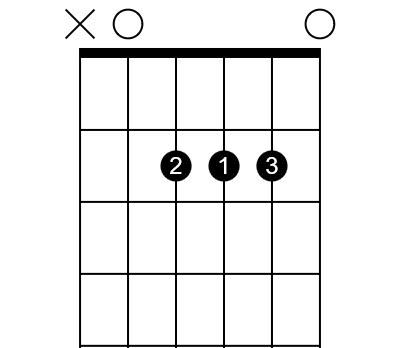
Look back at the picture at the top of this article. Notice how simple it is to make the open A chord on guitar. You only have one fret to worry about. And you use consecutive strings to play the chord.
As I mentioned in the caption to that picture, although many players will finger the A chord just as you see in the picture, that’s not my preferred fingering. I’ve got good reasons for the fingering I suggest, which you can see in this chord diagram.
While my preferred fingering makes the chord a bit more complicated to play, it’s really not nearly as difficult as it first seems. If you stick with it, you’ll find you can easily get to it without any thought at all.
To learn more about my preferred fingering of the open A chord on guitar, read
You can easily bar and move the shape
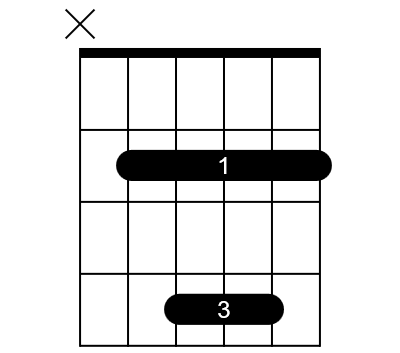
The technique of using bar (or barre) chords can transform your guitar playing. Once you progress beyond open chords, a world of possibilities opens up to you.
The shape of the open A chord is arguably the second most important shape for bar chords. It requires another fingering which presents its own challenges, but once you master it you will be able to play every major chord with that one shape. You simply move the shape to different frets to create different bar chords.
Because the open A shape is so easily moveable, it will become one of your most important shapes as you learn more about the guitar.
If you want to know more about moveable bar chord shapes, read
What you find inside an open A chord on guitar
We can deconstruct the open A chord on guitar to find several nuggets of useful guitar technique. The chord contains two valuable triad shapes. It also reveals Box 4 of the major pentatonic scale. Next, it’s custom made for playing alternating bass parts. And finally, it contains two power chord shapes.
Easy alternating bass possibilities
You might have noticed that even though the note E is part of the A chord, we typically don’t use the open Low E string when we strum the chord. That low E note just sounds to powerful and tends to dominate the chord, making it sound a bit muddy and less like an A chord.
However, that doesn’t mean that the open Low E remains useless. In fact, it becomes very useful when you play with an alternating bass note style of strumming or picking. That style is quite common in many genres and especially prevalent in country music.
But the open A chord provides another option for alternating bass notes too. Because the note on the D string is also an E note, it too works great with the alternating bass playing style.
Need to know more about alternating bass?
The A power chord
The same characteristics of the open A chord on guitar that make it so useful for alternating bass notes, also gives you two great power chord options.
Those E notes that I talked about above are the 5th degree of the A major scale. When you play just the root note and the 5th in unison, you have what’s known as a power chord.
Power chords dominate in some styles of music, particularly heavy genres like heavy metal and punk. But they’re useful in virtually every genre.
Because you have E notes surrounding the open A string in the open A chord shape, you have two great options for power chords. Actually three if you combine them.
First, play the open A and open E strings. That’s an inverted A power chord which has the 5th as the lowest note.
Next, play the open A and the E at fret two of the D string. That’s the root position power chord. Notice that this power chord may not sound as “big” as the inverted shape, but it gives more the character of an A chord since the root note is the lowest note in the shape.
Finally, if you combine the two, you have a power chord with an A sandwiched by two Es. It’s still a power chord, but it can really start to lose its A character since the E notes are so prominent.
Of course you can move any of these three power chord shapes to other frets in order to play every other possible power chord.
If you want to know more about power chords, read
First position triad
You’ll find the root position major triad inside the open A chord on guitar.
Look at the G, B, and High E strings. On these strings you have the notes A, C#, and E respectively. That’s the A major triad in root position.
This triad is highly useful in all types of guitar playing. Lead players find it especially useful because its high notes cut through the mix very well. It can be used for arpeggios, chord stabs, and other accenting techniques.
The triad shape is completely moveable, so you can use it to play any major triad you need just by moving to a different fret and playing the same shape.
You can find a full discussion of major triads at
Second inversion triad
The open A chord shape also contains a second inversion of the major triad. In the second inversion, the 5th scale degree note is the lowest of the chord. In the A triad, the 5th is E.
So, you can find this inversion on the D, G, and B strings. The E sits on the D string, the A sits on the G string, and you find the C# on the B string.
Again, you can move this triad to any fret to make every major chord. And since this triad uses a lower set of strings, it’s a little more powerful as a rhythm guitar element. Still, it’s very useful for lead guitar as well.
Box 4 of the major pentatonic scale
It’s quite useful to understand that Box 4 of the A major pentatonic scale exists around the open A chord on guitar. Or, as another way to look at it, the open A chord exists within the A major pentatonic scale Box 4.
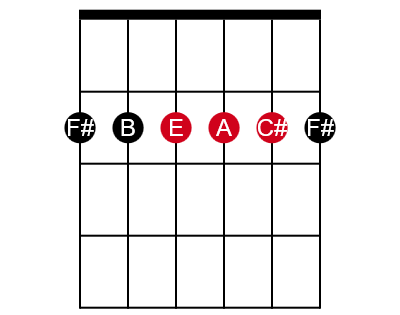
This figure shows the notes of the A major pentatonic scale. The red dots indicate the shape of the A major chord.
Notice that you can’t play the normal shape of Box 4 completely in this position on the neck since a couple of the notes in that box exist below the open string position.
Therefore, it’s a bit easier to see how the scale surrounds the chord shape if we move the shape up the neck. Let’s move the shape up an octave. In this figure you can see the full pentatonic scale and how the A shape (again shown with the red dots) sits within it.
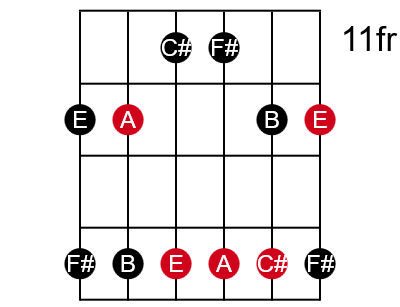
Understanding this is very useful when it comes to switching back and forth between playing chords and lead guitar lines.
Notice that you can visualize the bar with your pointer at fret 11 to play the A and E notes on the A and High E strings. Then the E, A, and C# notes on the D, G, and B strings respectively.
This figure also makes it easy to visualize the two triad shapes and the three power chord shapes we talked about earlier.
The E, A, and C# notes on the D, G, and B strings form the second inversion of the major triad. On the G, B, and E strings, the A, C#, and E notes form the root position of the A major triad.
If you’re really paying attention, you can even find another second inversion shape on the Low E, A, and D strings. That’s not a very common triad shape to play, but perhaps you could bring it into fashion! It can actually be quite useful as a rhythm guitar element.
For a full discussion of the major pentatonic scale, read
Conclusion
The open A chord on guitar holds a ton of useful guitar theory and technique. In addition to being one of the most useful open chords, its shape holds a ton of potential for creative guitar playing.
The chord’s full sound and relatively easy-to-play shape make it a staple for rhythm guitar accompaniment. At the same time, you can add a bar to it to make it completely moveable. Once you make the shape a bar chord, you can move it anywhere on the fretboard to play any major chord you need.
It also holds two useful major triads, three alternatives for playing power chords, and two alternating bass note options. It also integrates beautifully with Box 4 of the major pentatonic scale.
Clearly, there’s more to the open A chord on guitar than initially meets the eye. Get to know it, and you’ll open up a great deal of guitar knowledge.
